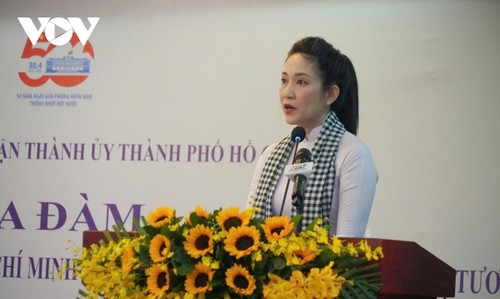 In 2022, Ho Chi Minh City launches a project to promote Hat boi (classical opera). (Photo: Minh Tham/VOV correspondent in Ho Chi Minh City) In 2022, Ho Chi Minh City launches a project to promote Hat boi (classical opera). (Photo: Minh Tham/VOV correspondent in Ho Chi Minh City) |
Over the past 50 years, Ho Chi Minh City’s cultural and artistic sector has supported and stood by its people, enriching their spiritual life even through challenging times. Local artists and writers have produced high-quality works that have elevated the cultural life of local residents and inspired communities across the country.
Today, Ho Chi Minh City is the hub of Vietnam’s film industry, home to 100 registered film production and distribution companies. In the realm of theatrical arts, the city has cultivated a golden generation of talented artists like Kim Cuong and Kim Xuan.
Traditional art forms like Cai luong (reformed opera) and Hat boi (classical opera) are associated with famous artists like Bach Tuyet, Le Thuy, and Minh Vuong. According to People’s Artist Nguyen Thi Thanh Thuy, Deputy Director of Ho Chi Minh City’s Department of Culture and Sports, the city’s literature and arts have strongly encouraged the people to fulfill Vietnam’s political objectives in the new context.
“Many private companies and corporations have built brands through their involvement in art programs like Call Me By Fire and Brother ‘Say Hi’,” said Thuy.
97,000 people are working in Ho Chi Minh City’s culture and art sector. There are more than 17,000 businesses in the field, accounting for 7.7% of all city enterprises. Cultural enterprises are growing at an average rate of 14% annually and contribute about 5.7% of the city's GRDP. Arts and culture not only enrich the spiritual life of local residents but also play a significant role in the economy of both the city and the nation.
The municipal government has created a supportive environment that allows artists to unleash their creativity. Ho Chi Minh City has identified eight areas of focus for the development of its cultural industries – film, performing arts, fine arts, photography, exhibitions, advertising, cultural tourism, and fashion. These sectors are expected to become key drivers of socio-economic development, international exchange, and enhancing the image and status of Ho Chi Minh City and its people.
“We hope that in this new era local artists will continue to be pioneers on the cultural front, making meaningful contributions to the city’s culture and the nation’s cultural industry,” People’s Artist Nguyen Thi Thanh Thuy said.
 People’s Artist Nguyen Thi Thanh Thuy, Deputy Director of Ho Chi Minh City’s Department of Culture and Sports. (Photo: Vu Huong/VOV correspondent in Ho Chi Minh City) People’s Artist Nguyen Thi Thanh Thuy, Deputy Director of Ho Chi Minh City’s Department of Culture and Sports. (Photo: Vu Huong/VOV correspondent in Ho Chi Minh City) |
In the context of accelerating industrialization, modernization, and global cultural integration, those working in culture and art fields are striving to meet growing public demands and build a strong cultural industry that produces high-quality works. This effort will sustain cultural development, build “soft power,” and reinforce the Ho Chi Minh City brand.